
Original Link: https://www.anandtech.com/show/2153
CES 2007 - Part II: IPTV on Xbox 360, iPhone and DTX
by Anand Lal Shimpi & Manveer Wasson on January 16, 2007 12:00 AM EST- Posted in
- Trade Shows
Over the past decade, Intel, Microsoft and the gamut of PC technology leaders have been saying that convergence is coming. Years of Intel Developer Forum keynotes were full of talking about the future and convergence and how it was just around the corner. Yet every year we found ourselves wondering when it was really going to happen. It seems like one night the industry went to bed and when we all woke up the next morning, convergence had happened.
Our first CES article had that phrase in its title: "Convergence Happened", because indeed it had. Last year's CES seemed very much like two discrete industries (PC and CE) meeting awkwardly at a single trade show; this year's CES however felt like the two had been married for years, and now it was only a question of which devices would do convergence well. When we say convergence, we're speaking of the intersection of the PC and Consumer Electronics industries where both types of devices can work together, often enabled by so-called convergence devices.
The debate over this convergence of PC and CE technologies mainly revolved around what technology would be the center of the digital home. PC companies like Intel and Microsoft felt it would be the PC, while CE companies like Sony wanted it to be a CE device. While the race is far from over, it looks like Microsoft and Intel have an early lead, as the PC is most definitely the center of the digital home today.
The center of the digital home doesn't necessarily have to be the most frequently used device in the home, rather it is the device that enables all of the other devices in the digital home. In Microsoft's digital home, that device is currently a reasonably powerful Windows XP PC; in the future, it will be a Windows Home Server PC. Your content is stored on that computer, your emails, music, videos, everything. Other devices revolve around it by either syncing to it or streaming data from it. For example, your iPod or Zune syncs music to it, and your Xbox 360 streams videos from it.
It's amazing how much Microsoft has been able to do with the Xbox 360 in just over a year of it being on the market. While Microsoft had lofty goals for the original Xbox, the only people who were able to use it as more than a DVD player/game console were those who modded the console to support homebrew applications like Xbox Media Center. The 360 however is a different story entirely; it's already more than a game console. It's not that Microsoft did anything earth shattering with its Xbox 360 and Live strategy, it's that it was the first time a convergence device was even remotely well executed. Microsoft has spent the past decade trying to get a PC into the living room, and at the end of the day all it took was an Xbox.
You see, everyone has been in search of what Microsoft has been able to put together with Windows and the Xbox 360. Sony's attempt centers around the PS3, coupled with intelligent TVs, Blu-ray players and other CE devices. And Apple's attempt, well Apple's attempt is a little different.
Today's article focuses on some of the convergence related news that happened around this year's CES. From Microsoft's Xbox 360 IPTV announcement and the iPhone to AMD's new form factor, it's all part of a much bigger picture that will impact all of our lives.
TV is Changing
As we've mentioned before, the end game of convergence is pretty straightforward: access to all of your content, anywhere on any device. In the early days of multimedia computing, all of your music and video content was stored on CE devices. Cassette players gave way to CDs, VHS to DVDs, and of course there was always cable TV. As PC technology grew faster and smarter, content began shifting from CE devices to PCs. From MP3s and DivX movies to Youtube, some of the most used content these days can't even be played on run of the mill CE devices.
Microsoft's approach plays out like this; you get content on the Internet through your PC, which is most likely running a Microsoft OS. But the chain continues now with the Xbox 360, which can stream content from your PC to your TV. Currently Microsoft limits the type of content you can stream from your PC to the 360 (it has to be WMV encoded), but there are 3rd party apps that will transcode from virtually every format to WMV for streaming to the 360.
Xbox 360 users also have the option of downloading content off of the Xbox Live Marketplace, which as of the end of last year includes renting full length movies and buying TV shows. As a game console, getting this content on your TV is as simple as downloading it.
The final frontier for Microsoft however is attempting to control the cable TV market. The PC market is already pretty much dominated by Microsoft, and the next-generation console race has left the Xbox 360 in the lead, leaving the TV/CE side of things untapped. Microsoft has tried to break into the TV market in the past, with things such as Ultimate TV, but success by Microsoft's standards hasn't been in the cards. With the possible transition to IPTV however, Microsoft feels that it has potential to control a big chunk of the market.
Being able to control the platform which TV is delivered is most of what Microsoft's Xbox 360 IPTV announcement was about at this year's CES. The idea is to leverage the current installed base of Xbox 360 consoles as potential customers for IPTV, which makes providers happy and gives Microsoft the marketshare it wants. The final piece of the puzzle works like this: content that would normally appear on cable networks is delivered on an IPTV network (e.g. Verizon FIOS or AT&T U-Verse) to the Xbox 360, which then obviously ends up on your TV.
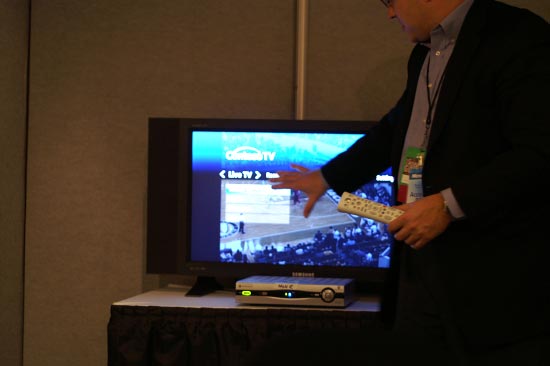
At CES, Microsoft gave us a demonstration of the upcoming Xbox 360 IPTV solution which is supposed to be released sometime in 2007. Enabling IPTV support on the 360 will be as simple as a software update that will add a Television button to the Media blade in the 360's UI.
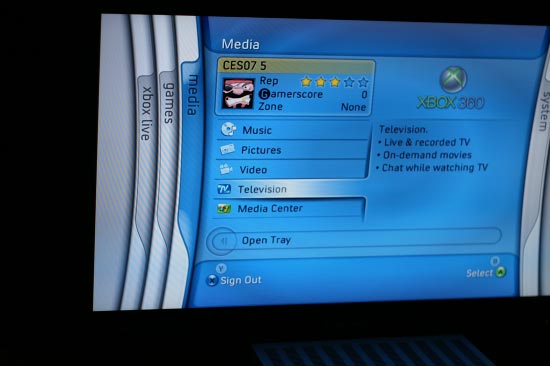
The 360's IPTV software is no different than Microsoft's current IPTV software, meaning it doesn't look like it's integrated with the 360's look and feel too much. Launching the IPTV software takes a few seconds as it authenticates your hardware and account information, but afterwards it's a fully functional set-top box. One of the most tangible benefits of an IPTV solution is extremely fast channel switching, much faster than current digital cable offerings; Microsoft's IPTV implementation both on set-top boxes and the Xbox 360 can switch channels in 300 ms.
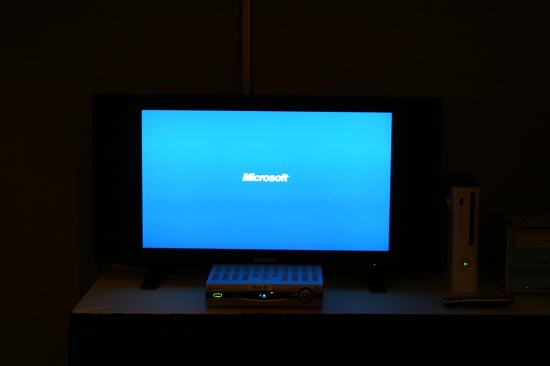
Microsoft's IPTV Interface launching on the 360
The goal here isn't to require Xbox 360's for each TV that you want to watch your IPTV on, but rather let you use your 360 as a set-top box if you happen to have one. The 360 will function as a HD-DVR, recording at least two streams simultaneously. You'll still be able to record a program and play a game at the same time, and while watching TV you still have access to your friends list and all of the other Xbox 360 navigational tools. Microsoft's demonstration was seamless, you couldn't tell that the IPTV software was running on a Xbox 360 until you hit the Xbox button on the remote control.
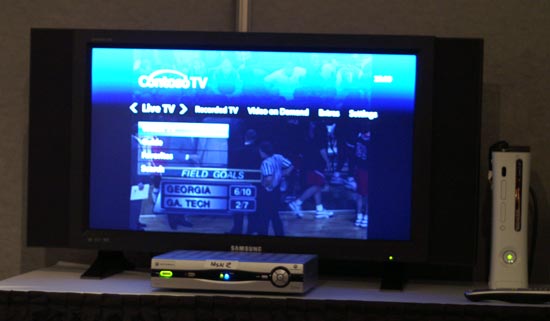

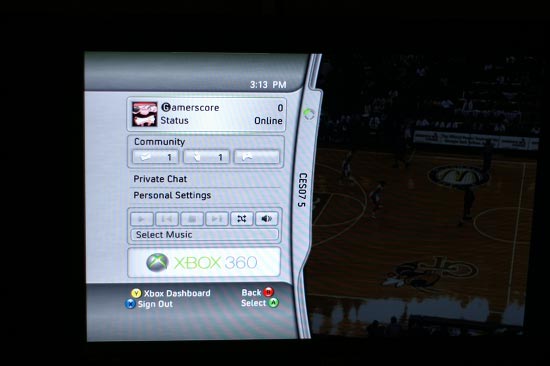
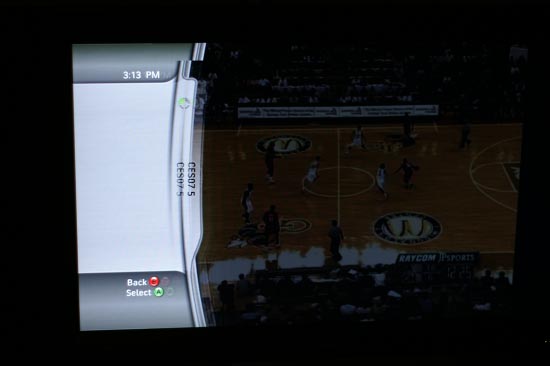
We asked Microsoft if you'd be able to use the 360 as a IPTV receiver even if the provider wasn't in your area, thereby introducing a significant amount of competition to the fairly monopolistic cable market. Unfortunately, IPTV networks are designed to be managed networks, not simply video over the public Internet network, and thus your IPTV traffic will flow entirely within your ISP's network. In other words, your IPTV provider needs to be in your area in order for you to get service.

Like any other cable TV service, there will be a cost associated with the Xbox 360's IPTV, but we'd expect it to be competitive with other options. At first glance the technology sounds cooler than it actually is, after all, your 360 ends up being nothing more than a cable box at the end of the day. But the real story is in what it turns your Xbox 360 into - a true media hub in your living room. With IPTV support, the Xbox 360 would be able to play any content, whether it's on a TV network or on your PC, on whatever it's hooked up to. It all but completes the digital home; taking that DVR'd content with you on the go would be the next step.
Apple's Approach
We've seen Microsoft's approach, but what about its biggest threats? A few pieces of the Sony puzzle have been unveiled over the previous months, although honestly it doesn't seem very well assembled at this point. The PlayStation 3 does have an online service, but it isn't what Xbox Live is (not yet at least). We previewed Sony's Bravia Internet Video Link in our earlier CES coverage, but the device is fairly limited in the type of content you can stream to your TV - only allowing selected content from a handful of web portals.
Given the pressure Apple has put on Microsoft (not with marketshare, but with featureset), it isn't surprising to see competition from the industrial designers in Cupertino. The goal again is to be able to stream content from your computer, in this case a Mac, to virtually any other device in the home - starting with the TV.
Apple already has the MP3 player market with its iPod, which can play both audio and video content. And the recently introduced iPhone addresses much of the same market as the iPhone in terms of being able to take your content with you wherever you go. Apple's main limitation however is that it has no competitor to Microsoft's Media Center, television in its conventional form remains untapped for the company. Thus Apple's strategy has to change a bit and instead of attempting to produce a product that will record and archive cable TV broadcasts, Apple leveraged one of its most successful products to date: the iTunes Store.
For Apple, the iTS is the closest thing it has to an IPTV network; you can download the TV shows and movies you want and watch them on your Mac or iPod. Obviously there are limitations, as not every show you want to watch is available in the iTS and you don't get to download the shows the minute they air, but it's the only option for Apple currently. You could even view Apple's iTS as the first DRM enabled (aka legal) a la carte cable solution, that just happens to be available over the Internet. In theory if all you watched were a handful of shows, that were all available on the iTS then you wouldn't need cable, just pay for the shows you watch and you're set.
While we're not sure about the number of users that actually use the iTS as a cable TV replacement, it's clearly a big part of Apple's vision and the only way it can compete as you're not going to see an Apple IPTV solution anytime soon. The problem is that until now, there's been no good way of getting all of this content you've bought off the iTS onto your TV. Enter Apple TV.
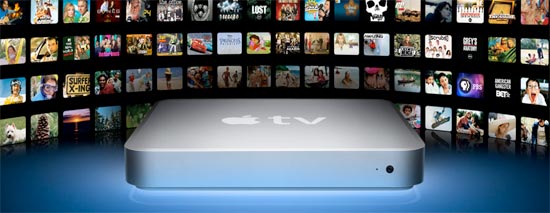
The Apple TV product is designed to bridge the last gap between your content and your TV, taking content stored on your Mac and streaming it to your TV. It's Apple's entry into the living room, as it doesn't have a gaming console or other device that naturally resides there like Microsoft at this point.
Apple TV is merely Apple's attempt at a digital media extender, similar to what we've seen from so many other companies. The difference here is that Apple not only makes the hardware, but also provides the software and service that people use to obtain the content being streamed. As such Apple TV appears to be best tailored to Mac or PC users that happen to get a lot of their audio and video content off of iTunes. The unit itself is limited in the type of content it will decode, and pirated DivX movies aren't on the short list; as such, Apple TV's success will be among a very particular group of users.
We wouldn't expect the growth rate of Apple's TV product to be incredibly fast and without support from the enthusiast community (which would undoubtedly support a product if it offered greater flexibility in what sort of content it would stream), we're not sure where the product will end up in the long term. Apple does have a long list of products that were good ideas but never grew to iPod popularity levels, and at least in its first iteration the Apple TV may be no different. Long term success aside, looking at Apple TV as a piece of the larger digital home puzzle you can see that Apple recognizes the same thing Microsoft does - it needs a box in the living room and it needs a way of getting content from your PC (or Mac in this case) to that box.
The Issue with All Approaches
Apple, Microsoft and Sony aren’t the only companies trying to do convergence right; at CES we saw companies from HP to Netgear and D-Link all with their own attempts at connecting your PC to your TV. Unfortunately there’s no one device or set of devices that appears to do it all.
Part of the problem is that there is no clearly superior way to actually get content legally onto your PC. With the exception of the iTunes Music Store, which has been immensely successful in the music market, buying content legally is basically offered through a fragmented set of movie and TV download services. And with no clearly superior way of handling electronic distribution of content and DRM, much of the content stored on computers these days isn’t exactly legal. Most manufacturers shy away from making it easy to play content in commonly pirated video formats, e.g. DivX, which ends up making many of these digital media extender devices useless.
For years the PC industry was fighting for convergence, trying to get its side of the technology powerful and polished enough to actually support and drive consumer electronics devices in the home. That part has happened, now it’s more an issue of who is going to do convergence right, and this question is far less dependent on simply getting more powerful hardware on your network.
The issues surrounding approaches to DRM have made consistently headlines for the past couple of years in the technology world, but now the stakes are even higher. All of the major players want to be the one to figure out the model that works the best so that they may capitalize on convergence. Until one of them figures it out however, we’re bound to see many failed attempts at connecting the digital home, and many attempts that only bridge half the gap.
Apple’s iPhone
For a while there I’d get just about every Pocket PC that was released with the hope that I’d actually use the new device. Even after the switch to Windows Mobile, the I found myself with a bunch of PDAs that I used only for a short while before the cool-factor wore off and the fact that they weren’t very useful just settled in.
You’d think that over the past decade cellphone makers would be able to perfect these devices that have so ultimately penetrated our lives. In many senses they have, but the one area that has gotten more cluttered than perfected has been in the user interface department. Cell phone UIs are basically an exercise in choosing between the lesser of two evils; of all of the great user interfaces developed in the PC technology era, cell phones are no where near the top of that list.
Smart phones are a bit better, but for the most part they have been victim of poorly scaled down interfaces of their desktop counterparts. What technologies like Intel’s Centrino and Microsoft’s Media Center Edition have taught us is that to truly build a successful product in a particular market, you have to tailor it to that market, you can’t simply use a scaled down version of a product aimed at a different segment and expect it to be perfect.
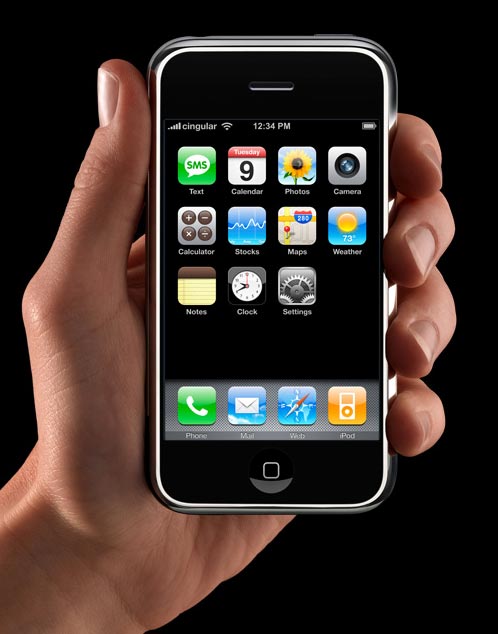
It’s in the UI that Apple’s iPhone is the most revolutionary, at least upon first glance. Those users who have pointed out that there’s nothing truly new about the iPhone are right; fundamentally most of the features of Apple’s iPhone can be found in other phones, but it’s in how those features that are implemented that set the iPhone apart from its competition.
At first glance the iPhone doesn’t look all that impressive, but in the usage videos at Apple’s site and during the Jobs keynote you really get insight into the strengths of the UI. Its speed, simplicity and organization of things like text messages and voicemails just makes sense, to the point where we wondered why it hadn’t been done before. Obviously there are a lot of unanswered questions about actual usage of the phone and the multi-touch screen, but what we’ve seen initially looks promising. If the iPhone ends up being a failure once you have the device in your hands, at least what we’ve seen from its UI can serve as a blueprint for future smartphone makers of directions to explore.

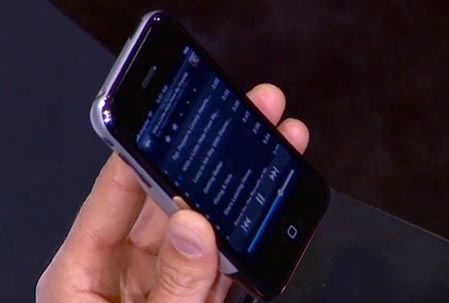
There will obviously be drawbacks to the iPhone, even the initial demo at Macworld wasn't without flaws. Touch typing will be difficult on a device that provides no tactile feedback, web page rendering speed during Steve's keynote wasn't exactly fast, and neither is Cingular's EDGE network that the device will operate on.
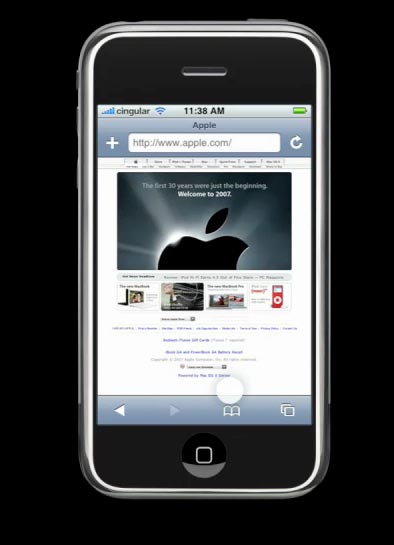
What about cost? Apple has built its business around selling products that command a premium over competitors that fundamentally have a product that has similar functionality. At $499 and $599, the iPhone may be unreasonable for most, but Apple has never built products for the majority of the market. Its pricing won’t lead to failure, but it will not overtake Motorola, Nokia and Sony Ericsson as the leaders in the cell phone market. Don’t expect the iPhone to take significant marketshare away from RIM and its Blackberry devices, although it could significantly hamper RIM’s efforts to bring Blackberry to consumers rather than just enterprise customers.
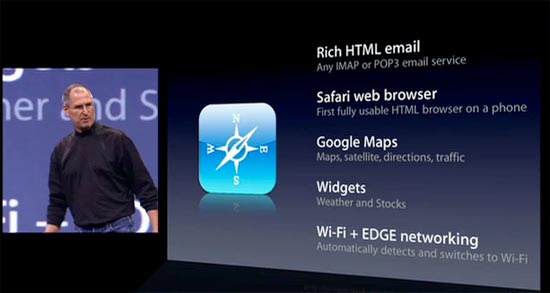
There are entirely too many enterprise features of Blackberry for the iPhone to offer true competition to it, but for consumer users who RIM hopes to convert with phones like the Blackberry Pearl, the iPhone may be tough competition. In fact, all smartphones in the iPhone’s price range are now at risk of some fierce competition by Apple’s offering. The reason being that a huge population of smartphone customers use their phones for one or more of the features that Apple included in the iPhone: email, web browsing, text messaging and voice. Being able to install your own applications would be nice but it’s not necessarily the type of functionality Apple is targeting with the iPhone; perfection enabled through simplicity is Apple’s game here. It aims to perfect some of the fundamental functions of smartphones and then worry about additional functionality at a later time. Part of the problem with the evolution of cell and smartphone UIs is that so much functionality kept on being added without ever perfecting the interface at any step in the game, leading to devices that can do just about anything at all, but nothing well.

In the world of convergence devices, the iPhone doesn’t actually win Apple any more ground, but it has the potential to truly revolutionize one more gadget we use on a regular basis. If not through the iPhone itself, through the many competitors to it that will undoubtedly rise over the coming years; just look at the effort Microsoft has put into Zune as a result of the iPod. Even if it isn’t met with a tremendous amount of success, whether or not you end up with an iPhone in your pocket the consumer stands to benefit tremendously.
AMD’s DTX Form Factor
As we talk about convergence and the future of the two combined industries, it's far too easy just to focus on the CE side of things - after all, gadgets tend to look cooler than the parts that make them up. That being said, today's story isn't all about cell phones and streaming video.
An unexpected announcement at CES was AMD’s commitment to develop a new open standard for small form factor computers: DTX. One of the major reasons for AMD's acquisition of ATI was to get into the consumer electronics business, which ATI happened to be reasonably successful in thanks to its DTV chips and console GPU designs. The intent to develop a new small form factor specification fits very well with AMD's desire to break into the CE market, as CE devices don't tend to be in large ATX cases.
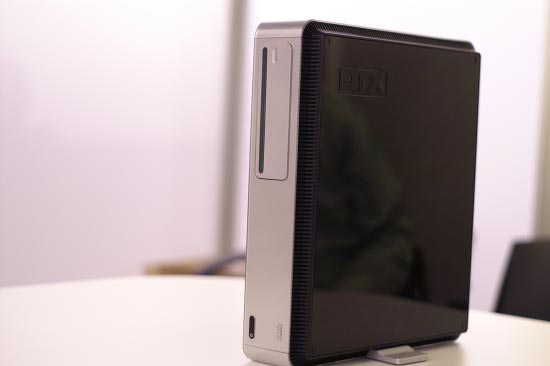
AMD's DTX demonstration chassis
If this sort of announcement sounds familiar at all, it’s because Intel tried to do the very same thing with BTX not too long ago. For years it seemed as though a small form factor standard for PCs was inevitable; we were seeing many proprietary form factors enter the marketplace to fill a very large void left by ATX. Companies like Shuttle profited tremendously from the lack of a small form factor standard as they were able to deliver cases and motherboards that were significantly smaller than anything you could get with ATX. But even during the earliest days of proprietary SFF systems, it was clear that a standard was needed.
The entire PC industry as we now know it was built upon standards, so consumers would have choice in their components, not to mention a guaranteed upgrade path. If you bought a proprietary SFF system, you were married to the motherboard you bought with the system; if you wanted an upgrade, you needed to buy a new SFF. It’s a great business proposition for the manufacturers, but not so great for the consumers.
Intel introduced the BTX specification and its three variants (standard, micro-BTX and pico-BTX) back in 2003, but since then there has been limited acceptance of the standard. Motherboard and chassis manufacturers were extremely slow to adopt the BTX spec, eventually pulling virtually all support for the standard. AMD on the other hand was fairly adamant about why it never really embraced BTX; AMD insisted that BTX was created first to cope with the rising power demands of Intel’s Pentium 4 line of processors, and only address the need for small form factor PCs as a secondary goal. While we’ve seen one AMD BTX board on display, the vast majority of BTX motherboards were Intel-only.
Interest in BTX has faded considerably over the past four years, particularly in the channel market. Even Intel's own motherboard lineup will phase out BTX support starting in Q2 of this year. Instead of throwing its weight behind a failed standard, AMD set out to create a new small form factor specification with the help of its partners.
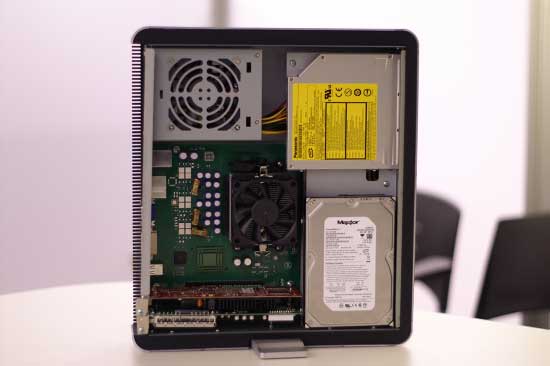
A DTX mockup
AMD doesn’t intend DTX to replace ATX, but rather supplement it for manufacturers and consumers interested in a smaller form factor. DTX will use the same standoff hole pattern as ATX, so DTX motherboards will work in ATX cases. Going one step further, mini-ITX motherboards will work in DTX cases, which will help leverage one of the more popular form factors in the SFF marketplace. There's also a mini-DTX specification that AMD is working towards developing for even smaller form factor applications.
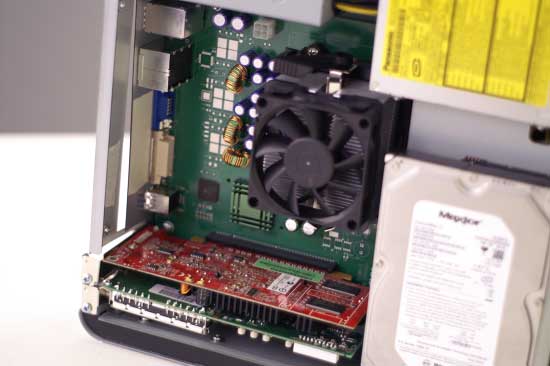
Note the use of half-height expansion cards, and fairly low profile CPU heatsink
AMD plans on having the initial draft of its DTX specification ready sometime this quarter, although we didn’t get any solid details at the show itself. AMD did mention that the DTX specification would be designed for CPUs with a TDP less than or equal to 65W, which happens to be the TDP for all of AMD's newly announced 65nm CPUs.
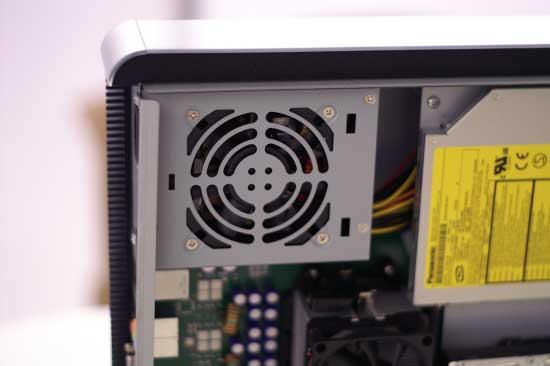
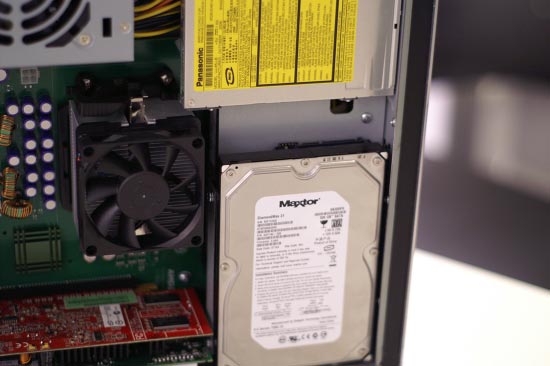
We asked AMD why it would bother with a new standard when a small form factor standard already existed with BTX, but we weren't able to get a satisfactory answer other than the usual company line of: BTX was designed to fix an Intel thermal problem, DTX is an open standard for small form factor PCs.
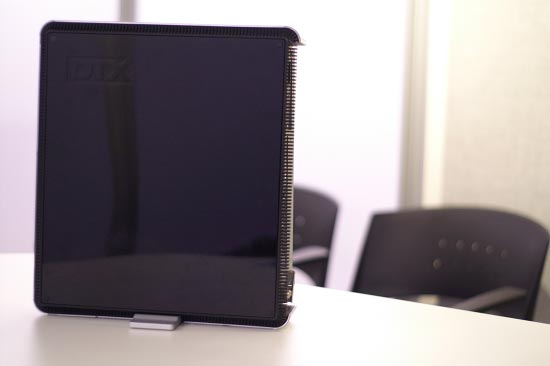
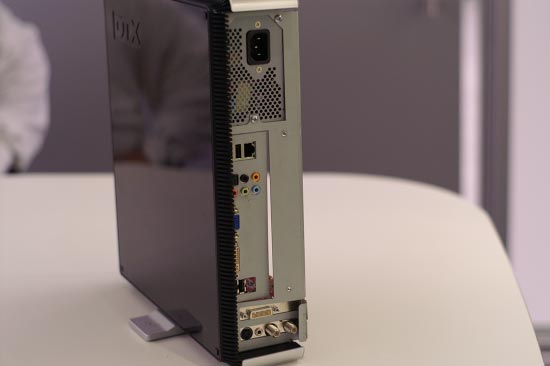
Despite the me-too approach that AMD appears to be taking with DTX, it's already looking to have a higher potential for success based on the simple fact that you can use DTX motherboards in ATX cases. By not having to create two different motherboards, supporting DTX from a manufacturer's standpoint is far less of a risk. The real question is whether or not AMD will be able to put enough resources behind DTX to make it a widely accepted industry standard.
Final Words
As a show, this year's CES was relatively disappointing. We spent far more time walking around the show than actually seeing new product and honestly, one of the most interesting announcements wasn't even at the show but rather at Macworld in San Francisco. However disappointing the show was, it served as an example of the upcoming struggles in this new world of PC and CE technology convergence.
As we've already mentioned, convergence is no longer about if or when, but how and who. The culmination of decades of evolving PC and CE technology has left us with an industry that has the ability to do much, but remains largely untapped. In many ways, AMD's DTX announcement highlights a major necessity for the next-generation of convergence products to succeed: standards.
The entire PC industry was built around standards and companies doing their best to achieve greatness within the confines of those standards. For us to truly have useful convergence products we need the same sort of consumer influenced standards; with everything from DRM to cellphone platforms, unity and interoperability are necessary to build useful products in the convergence space.
With its Vista, Xbox 360 and IPTV strategy, Microsoft appears to have its mind (and products) in the right place. In one fell swoop Microsoft broke into the living room, a part of the digital household that everyone had talked about entering but few actually had.
As competitive as Apple has become in the past couple of years, it's tough to compete with Microsoft's strategy when it comes to infiltrating the digital home. However with the success of the iPod and initially looking at the iPhone, it appears that Apple's greatest chance for success in the current convergence market is when you're outside of your digital home. At first glance, the iPhone appears to be what we've wanted from PDAs and later from smartphones for years now. As always, we'll have to reserve judgment until we've got a unit in hand but the demos look impressive.
One thing is for sure; the market is changing, and the coming years will be filled with many frustratingly poor attempts at intelligent devices. If the PC industry's evolution is any indication, the result of a bit of suffering will be a much more fun world for technology enthusiasts.







